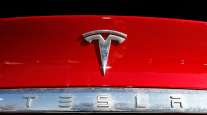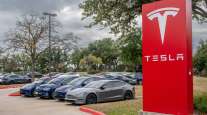Here Are Eight Things to Watch for in Tesla’s Big Rig Reveal

Tesla Inc. is finally ready to introduce its first all-electric heavy-duty truck. In the works for two years, it’s a project that’s aimed squarely at cleaning up the freight industry, which accounts for one-fifth of global oil demand.
Tesla will be showing off its Semi at its Design Studio in Hawthorne, California on Nov. 16 at 8 p.m. on the West Coast (follow it live here). CEO Elon Musk has promised a truck that will “out-torque any diesel semi” and drive “like a sports car.” Seeing what an all-electric semi is capable of may be the most entertaining part of the night, even if it’s not a key metric for Tesla’s trucking customers. “If you had a tug-of-war competition,” Musk bragged at a Ted Talk in April, “the Tesla Semi will tug the diesel semi uphill.”
Coming Nov. 17: LiveOnWeb's 'Powering the Trucks of Tomorrow'
Here’s what we’ll be watching for at the party, including some potential wild-cards:
1. How Long Is Long Range?
The range of any electric vehicle is the critical metric—it defines how the vehicle can be used and the size of its potential market. Five years ago, few would have thought that a long-range heavy duty-truck was even possible. That’s changing fast. Daimler, the leader in Class 8 diesel trucks, recently unveiled a 220-mile range electric big rig, establishing a new bar for the industry. Long-range hauling across vast stretches of the U.S. would likely require more than 500 miles of range.
RELATED: Tesla’s new semi already has some rivals
2. At What Cost?
Batteries are the single most expensive component of any electric truck, and the battery of a cross-country hauler could cost $100,000 even before you build the truck around it. The sticker price, regardless of size, is going to be higher than its diesel equivalent because of those pricey batteries.
Can Tesla keep the upfront price low enough to be offset by cheaper operating costs from fuel savings and simpler maintenance? Tesla may provide such figures, though many fleet operators will want to put them to the test with hundreds of thousands of road miles before they’ll be convinced.
3. Platooning on Autopilot
Will the truck, expected to roll out by 2020, come with some level of autonomous driving? Tesla has been in talks with California and Nevada regulators about testing semis that can automatically follow a lead vehicle, a technique known as “platooning.” Platooning cuts fuel costs by reducing wind drag. And if the autonomous driving system is good enough to run without a driver, it could also dramatically cut labor expenses.
A teaser animation released by Tesla on Nov. 15 suggests the realization of one of Musk’s design aspirations: cameras instead of rearview mirrors.
Tesla Semi unveil, 8pm PT tomorrow — watch live at https://t.co/8uVlhvzpu5 pic.twitter.com/hCIm5iCW6J — Tesla (@Tesla) November 15, 2017
4. Who Are the First Customers?
The biggest players in freight are good at keeping their trucks in top driving condition and averse to messing with the supply chain. Convincing companies like Swift, Ryder, and Wal-Mart Stores Inc. to bring an electric drivetrain into their fleets will be a tough sell. Musk says Tesla has been gathering feedback from trucking companies throughout the development process (at least one, Ryder, confirmed it), so it would be a good sign if Tesla comes out of the gate with some early partnerships.
Ryder Supply Chain Solutions ranks No. 13 and Swift ranks No. 7 on the Transport Topics Top 100 list of the largest North Ameican for-hire carriers.
It could be that Musk’s own empire will be the first demonstration customer of the big rig. Tesla’s automotive reach is growing, and its SolarCity arm is the biggest rooftop solar installer in the U.S. Musk’s SpaceX could potentially use the vehicles to transport rockets, satellites, capsules, and equipment.
During earlier unveilings of Tesla’s passenger cars—the Models S, X and 3—the company started taking paid reservations immediately, at least 18 months before the first deliveries. Is that a strategy that can work with commercial trucks? How long until the first rigs hit the road?
5. Infrastructure Solutions

A plug sits connected to a Tesla Inc. Model X electric automobile at a charging point in a parking lot in Frankfurt, Germany. Alex Kraus/Bloomberg News.
A lot of infrastructure goes into servicing big rigs. Truck stops line the world’s highways, and fleet operators stand by with mountains of replacement parts ready to fix anything that might go wrong. How does Tesla plan to deal with these hurdles? Will they introduce a whole new type of charging system, with ultrafast chargers or a robot that swaps out used batteries for fresh ones? Who will build out and operate the charging network? Who handles maintenance and roadside assistance?
6. Location, Location, Location
Tesla’s car factory in Fremont, California, is running out of room. Musk wants to build 500,000 electric passenger cars there next year, and even if he misses that goal by half, it’s very unlikely Tesla would be able to squeeze in a big rig assembly line. Tesla’s massive battery factory near Reno, Nevada, which is still under construction, seems like a more natural fit. That factory is also where Tesla makes electric motors and drivetrains—primary components for an electric semi.
It can transform into a robot, fight aliens and make one hell of a latte pic.twitter.com/8h9vvWu4f5 — Elon Musk (@elonmusk) November 15, 2017
7. “Driver Comfort Features”
In a profile in this week’s Rolling Stone, Musk hinted at an unspecified “driver comfort feature” that he’s fond of. “Probably no one will buy it because of this,” he said, “but if you’re going to make a product, make it beautiful.” One possibility? A sweet coffee maker. In a Twitter post on Wednesday, Musk joked that the truck “can transform into a robot, fight aliens and make one hell of a latte.”
8. Shared Parts
Perhaps Tesla’s biggest advantage over other truck makers is that its Semi will share some core parts with its first mass-market car, the Model 3. Musk disclosed during an earnings call in May that the Semi uses “a bunch” of Model 3 motors, which sit in line with the truck’s axles. These relatively cheap electric motors will give the Semi unparalleled electric torque for getting quickly up to speed with a heavy load.
Tesla’s foray into commercial trucking is coming at an impossibly tough time for the company. The Model 3 is already months behind schedule, and Tesla is spending $1 billion a quarter to get things cranking.
But if Musk can get Model 3 production lines up to their promised rates, and the motors and battery cells are truly interchangeable between the Semi and the new passenger car, the scale of those operations would be profound. While traditional diesel truck makers are testing truck-suitable electric motors by the hundreds, Tesla could be making them by the hundreds of thousands—even before its first big rig hits the road.





